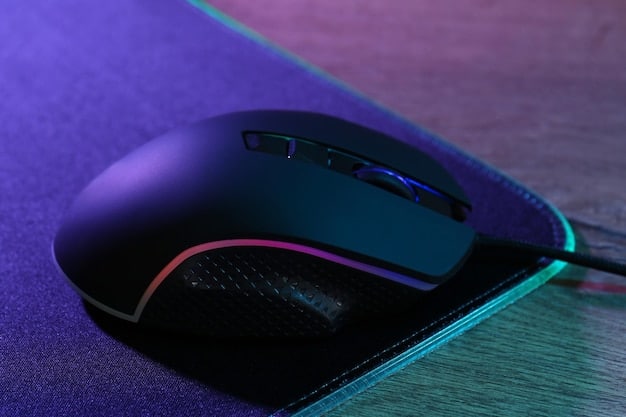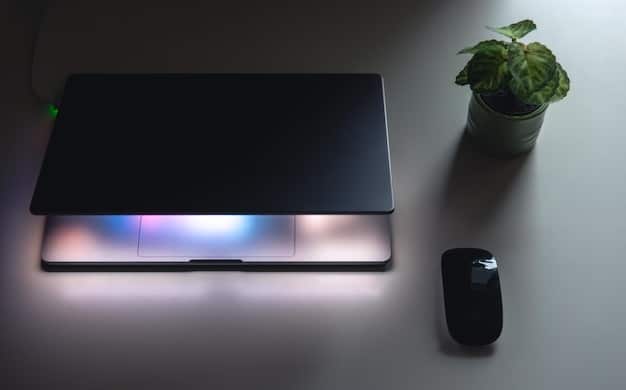Is Your Gaming Mouse Holding You Back? 5 Signs to Upgrade in 2025

A outdated or underperforming gaming mouse can significantly hinder your competitive edge and overall enjoyment; recognizing key indicators such as inconsistent tracking, discomfort, and unresponsive buttons is crucial for determining when a hardware upgrade is essential to optimize your gaming experience in 2025.
In the rapidly evolving world of gaming, your gear can be the thin line between victory and defeat. If you’ve been wondering, Is Your Gaming Mouse Holding You Back? 5 Signs It’s Time to Upgrade in 2025, you’re in the right place. A seemingly minor detail, your mouse plays a colossal role in precision, speed, and comfort. Many gamers overlook its impact, attributing poor performance to skill gaps rather than hardware limitations.
The Evolving Landscape of Gaming Peripherals
The gaming industry never stands still, and neither do its peripherals. What was considered cutting-edge technology just a couple of years ago might now be a bottleneck for your performance. From sensor technology to ergonomic design and wireless capabilities, gaming mice are constantly being refined to offer an unparalleled advantage. Understanding this continuous evolution is the first step in assessing whether your current mouse still meets the demands of modern gaming.
As games become more graphically intensive and competitive, the need for precise input devices grows exponentially. Latency, polling rates, and DPI levels that once seemed adequate can now be detrimental in fast-paced competitive titles. Manufacturers are investing heavily in R&D to push the boundaries, offering features that promise quicker reaction times, smoother tracking, and enhanced durability. This rapid advancement means that holding onto an older model for too long can put you at a significant disadvantage against opponents equipped with the latest tech.
Sensor Technology: The Brain of Your Mouse
At the heart of every gaming mouse is its sensor, responsible for translating your physical movements into on-screen action. Older mice often feature less advanced sensors that can suffer from acceleration, deceleration, or simply a lower maximum DPI/CPI. These issues can lead to inconsistent aim, missed shots, and overall frustration.
- Optical vs. Laser: While both have their merits, modern optical sensors (like PixArt’s PMW3360 series or newer) are generally preferred by competitive gamers for their raw, unflinching 1:1 tracking.
- DPI/CPI Range: Higher DPI isn’t always better, but a wider range offers flexibility. Modern sensors provide high maximums without interpolation, crucial for diverse gaming styles and resolutions.
- IPS (Inches Per Second): This metric indicates how fast you can move your mouse before the sensor loses track. Higher IPS ratings prevent “spin-outs” during rapid movements, a common issue with older or budget sensors.
Ergonomics and Design: Comfort for Performance
Beyond raw performance, how a mouse feels in your hand is paramount. An ergonomically flawed mouse can lead to discomfort, fatigue, and even chronic injuries like carpal tunnel syndrome, drastically impacting your gaming sessions and long-term health. The design of gaming mice has seen significant advancements, catering to various grip styles and hand sizes.
Many modern mice feature modular designs, adjustable weights, and textured grips to provide a customizable and secure hold. The right fit ensures that you can game for extended periods without pain or loss of control, allowing you to focus purely on the game.
Moreover, the weight distribution and balance of a mouse can profoundly influence flick shots and precise movements. A well-balanced mouse feels like an extension of your hand, reducing the effort required for acute adjustments and quick maneuvers, which is critical in competitive environments. The material quality and button placement also contribute to the overall user experience, directly affecting durability and accessibility of keybinds.
Sign 1: Inconsistent Tracking and Jitter
One of the most immediate and frustrating signs that your gaming mouse is lagging behind is inconsistent tracking or cursor jitter. Imagine lining up a perfect headshot, only for your crosshair to suddenly skip or twitch, ruining your aim. This isn’t just a minor annoyance; it’s a critical flaw that actively sabotages your performance in any game requiring precision.
Inconsistent tracking typically manifests as your mouse cursor not moving predictably in relation to your hand movements. This can be due to an aging sensor, dust accumulation, or simply a sensor that wasn’t designed for high-performance usage in the first place. Modern, high-quality optical sensors are engineered to provide pixel-perfect, 1:1 tracking, ensuring that every subtle movement translates accurately to the screen. If your crosshair feels like it has a mind of its own, especially during rapid movements or fine adjustments, it’s a strong indicator that your sensor is no longer up to par.

The Impact of Sensor Quality
Older mice or lower-end models often utilize sensors that introduce inherent flaws like “acceleration” or “angle snapping.” Mouse acceleration means that the distance your cursor travels on screen depends on how fast you move the mouse, not just how far you move it physically. This makes muscle memory incredibly difficult to build, as a fast swipe might cover a different distance than a slow swipe over the same physical distance on your mousepad. Angle snapping, on the other hand, tries to “smoothen” your diagonal movements into straight lines, which can feel unnatural and obstruct natural aiming.
Modern gaming mice with top-tier sensors explicitly avoid these artificial software enhancements, providing raw input that directly reflects your physical movements. This “raw input” is what competitive gamers crave, as it allows them to develop consistent muscle memory and achieve repeatable precision. If your mouse is hindering your ability to build this foundational aiming skill, it’s definitely holding you back.
- Skipping Pixels: During slow, precise movements, do you notice your cursor skipping pixels? This is a clear sign of poor sensor resolution or tracking limitations.
- Acceleration Issues: Perform a simple test: move your mouse slowly across a set distance, then move it quickly across the same physical distance. Does the cursor travel the same amount on screen? If not, you have acceleration.
- Random Jitter: Even with a clean surface, does your cursor occasionally make tiny, involuntary movements? This random jitter can be caused by sensor degradation or interference, especially with older wireless models.
Sign 2: Unresponsive Buttons and Double-Clicking
In the heat of a gaming session, every click matters. When your mouse buttons start failing to register inputs consistently, or worse, register multiple inputs from a single click (known as double-clicking), your gaming experience quickly devolves into frustration. This is a common wear-and-tear issue, especially with mice that use lower-quality switches or have seen extensive use over several years.
Mechanical switches, such as Omron switches commonly found in gaming mice, have a rated lifespan (e.g., 20 million, 50 million clicks). While these numbers sound high, professional gamers or even avid enthusiasts can accumulate clicks very quickly. Once a switch starts to degrade, it loses its tactile crispness, becomes mushy, and eventually, unreliable. A single click might not register, or the switch might “bounce,” registering two clicks instead of one. This can lead to misfired abilities, accidental weapon swaps, or failed interactions, costing you crucial moments in-game.
The Problem of Latency and Debounce Time
Modern gaming mice aren’t just about the switches themselves but also the firmware and technology surrounding them. Advanced mice often feature lower “debounce time,” which is the brief period a switch is ignored after an initial click to prevent accidental double-registrations. While essential, excessively long debounce times can introduce a minuscule but perceptible delay between your click and the in-game action, particularly in competitive titles where milliseconds count. Newer optical switches, for instance, eliminate debounce delay almost entirely, offering near-instantaneous actuation.
If you find yourself constantly battling your mouse to register a simple left-click or right-click, or if your abilities aren’t activating when you expect them to, it’s a clear signal that your mouse’s internal components are failing. This issue is particularly detrimental in games where rapid, precise clicks are essential for DPS rotations, spell casting, or shooting mechanics.
- Inconsistent Actuation: Are some clicks feeling different from others? Do you have to press harder sometimes to register an action?
- Ghost Clicks/Double-Clicking: A single press registers as two, or actions trigger without you specifically clicking. This is a tell-tale sign of a worn-out switch.
- Stiff or Mushy Buttons: The tactile feed-back from your primary buttons should feel consistent and crisp. If they’ve become stiff or lose their satisfying click, it impacts responsiveness and comfort.
Sign 3: Outdated Ergonomics and Discomfort
Gaming sessions can last for hours, and if your mouse isn’t ergonomically suited for your hand and grip style, you’re not just risking discomfort – you’re risking long-term injury. Stale ergonomics, where the design of the mouse doesn’t conform to best practices for hand health and natural movement, is a significant sign it’s time for an upgrade. Older mouse designs often prioritised aesthetics or basic functionality over intricate ergonomic considerations, which has become a major focus in modern peripheral design.
Prolonged discomfort during and after gaming sessions, such as wrist pain, finger stiffness, or general hand fatigue, is a glaring red flag. These symptoms aren’t just minor aches; they are indicators of potential strain injuries like Carpal Tunnel Syndrome or Tendinitis, which can severely impact your ability to game or even perform daily tasks. Modern gaming mice come in a vast array of shapes and sizes, meticulously designed to support different grip styles (palm, claw, fingertip) and hand dimensions, ensuring a more natural and less strenuous experience.
Finding Your Perfect Grip
The “perfect” mouse shape is highly subjective, but advancements in ergonomic research have led to a broader variety of well-engineered options. If your current mouse forces your hand into an unnatural position, or if you find yourself constantly adjusting your grip, it’s likely leading to unnecessary strain. New mice offer features like thumb rests, contoured bodies, and customizable side buttons that can drastically improve comfort and control.
Consider the material quality and texture as well. Slippery plastics or worn-out rubber grips can lead to a less secure hold, forcing you to grip the mouse tighter, which further exacerbates fatigue. Newer mice often incorporate advanced materials and anti-slip coatings that maintain a firm grip even during intense, sweaty gaming moments, enhancing both comfort and precision.
- Persistent Hand Pain: Any recurring pain in your wrist, fingers, or forearm after gaming is a strong sign of ergonomic issues.
- Fatigue During Sessions: If your hand or wrist gets tired quickly, even in moderate gaming sessions, your mouse might not be supporting your natural posture.
- Constant Grip Adjustments: Do you frequently find yourself repositioning your hand on the mouse to find a comfortable spot? This indicates a poor fit.
Sign 4: Outdated Connectivity and Lag Issues
While wired mice still have their place, the advancements in wireless gaming technology have been monumental. If you’re still tethered by a traditional wired mouse, or using an older wireless model prone to lag and interference, your connectivity might be a significant handicap. Modern wireless gaming mice have virtually eliminated the latency gap that once plagued their predecessors, offering freedom of movement without compromise.
Older wireless technologies often operated on crowded 2.4 GHz bands, making them susceptible to interference from other devices like Wi-Fi routers, cordless phones, or even microwaves. This interference could lead to noticeable input lag, dropped signals, and inconsistent performance – a death knell for competitive gaming. The convenience of wireless was often outweighed by its inherent unreliability for serious gamers.

The Dawn of Lag-Free Wireless
Today, high-end wireless gaming mice utilize proprietary technologies designed to ensure ultra-low latency and robust, interference-free connections. Technologies like Logitech’s LIGHTSPEED, Razer’s Hyperspeed, or SteelSeries’ Quantum 2.0 Wireless employ advanced frequency hopping, optimized data packets, and dedicated receivers to achieve latency comparable to, or even better than, many wired mice. This means you get the responsiveness you need without the drag and tangle of a cable.
Battery life has also seen significant improvements. Modern wireless gaming mice can last for dozens, even hundreds of hours on a single charge, making battery anxiety a thing of the past. Many also feature quick-charging capabilities or compatibility with charging pads, ensuring you’re always ready for action. If your current setup involves fighting with cables or constantly worrying about your wireless mouse losing connection, an upgrade is not just about performance, but also significantly enhancing your quality of life while gaming.
- Cable Drag and Snags: If your mouse cable constantly catches on your desk or peripherals, restricting movement, a wireless upgrade offers liberation.
- Perceptible Input Lag: Do your actions on screen feel slightly delayed compared to your physical mouse movements? This stutter can be a sign of poor wireless or even wired implementations.
- Frequent Disconnections: An older wireless mouse that frequently loses connection or experiences erratic behavior needs to be replaced.
Sign 5: Limited Customization and Macro Capabilities
In 2025, a gaming mouse isn’t just a pointing device; it’s a highly customizable extension of your gameplay strategy. If your current mouse offers minimal remapping options, lacks onboard memory for profiles, or has no sophisticated macro capabilities, you’re missing out on a significant competitive advantage. Modern gaming mice are usually paired with robust software suites that unlock a world of personalization, allowing you to tailor the device precisely to your needs across various games.
The ability to remap buttons is foundational. Beyond just adjusting DPI, top-tier mice allow you to assign complex macros, custom keybinds, and even execute multi-step actions with a single click. This can dramatically streamline gameplay, allowing for faster execution of combos in MOBAs, quick building in strategy games, or rapid utility deployment in first-person shooters. If your mouse is limited to its default functions, you’re not maximizing your efficiency.
Onboard Profiles and Game-Specific Settings
Many advanced gaming mice feature onboard memory, allowing you to store multiple profiles directly on the mouse itself. This is incredibly useful for gamers who play a variety of genres or frequently participate in tournaments where software installations might be restricted. You can configure unique DPI settings, button assignments, and macro sets for different games, and switch between them on the fly without needing to load software.
Furthermore, synchronization with other peripherals, dynamic RGB lighting for game alerts, and even surface calibration features are common in modern mice. These aren’t just aesthetic enhancements; they contribute to a cohesive and optimized gaming ecosystem. If your current mouse feels like a generic office peripheral when you try to customize it, it’s a strong indicator that its technological feature set is obsolete for today’s gaming demands.
- Lack of Programmable Buttons: If your mouse only has basic left/right click and scroll functions, you’re severely underutilizing its potential for game-specific actions.
- No Onboard Memory: The inability to save profiles directly to the mouse means you’re tied to software installations and lose settings when switching PCs.
- Limited Software Suite: If the accompanying software is clunky, unintuitive, or simply lacks advanced customization options, it hinders your ability to personalize your experience.
| Key Sign | Brief Description |
|---|---|
| 🎮 Inconsistent Tracking | Cursor skips, jitters, or feels unpredictable, directly affecting aiming precision. |
| 🖱️ Unresponsive Buttons | Clicks fail to register or lead to accidental double-clicks, hindering timely actions. |
| 🤕 Outdated Ergonomics | Mouse causes hand pain, fatigue, or discomfort during extended gaming sessions. |
| 🔗 Laggy Connectivity | Wired drag or unreliable wireless performance introduces input lag and disconnections. |
Frequently Asked Questions About Gaming Mouse Upgrades
Generally, a high-quality gaming mouse should last 2-3 years, but competitive gamers might consider an upgrade every 1-2 years to keep up with technological advancements and maintain peak performance. Casual gamers can stretch it longer, focusing on the signs of failure rather than rigid timelines.
Prioritize a high-performance optical sensor (e.g., PixArt 3360 or newer), low latency (especially for wireless models), durable switches (like Omron or optical switches), comfortable ergonomics for your grip style, and a lightweight design. A strong software suite for customization is also a major plus.
While a high DPI count (Dots Per Inch) indicates sensor capability, most gamers use significantly lower settings (400-1600 DPI) for precision. However, a wide DPI range is essential for flexibility across different game genres and monitor resolutions. Focus on consistent, true 1:1 tracking over raw maximum DPI.
In 2025, premium wireless gaming mice offer virtually identical or even superior performance to wired models, without the cable drag. Technologies like LIGHTSPEED or Hyperspeed have eliminated latency concerns. Choose wireless for freedom of movement if your budget allows for a high-end model; otherwise, a good wired mouse remains an excellent, reliable option.
Mouse weight is increasingly crucial, especially in fast-paced competitive games. Lighter mice reduce fatigue during long sessions and allow for quicker, more precise flick shots with less effort. While personal preference plays a role, the trend in professional gaming is towards ultra-light mice for maximum agility and responsiveness.
Conclusion
Ultimately, your gaming mouse is more than just an input device; it’s a critical component of your competitive arsenal and a direct link to your in-game performance. By genuinely asking Is Your Gaming Mouse Holding You Back? 5 Signs It’s Time to Upgrade in 2025, you empower yourself to make informed decisions that can elevate your gameplay. If you recognize any of the five signs discussed—inconsistent tracking, unresponsive buttons, ergonomic discomfort, outdated connectivity, or limited customization—it’s likely time to invest in a new peripheral. A modern, high-performance mouse can significantly enhance your precision, comfort, and overall enjoyment, ensuring you’re always playing at your absolute best.





